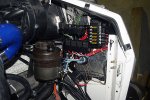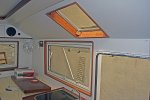Wiring
Nothing really that exciting to update. I am back at work on another contract, so progress has been slow, not much work done in the evenings due to getting home a bit late, but hopefully I should have things under control soon and will be able to spend a few evenings in from now on.
The saga continues with the interior fit out, and it looks like it might finally be coming to the end, in other words, all going well, the camper interior should be completed over the Easter weekend.
The main area I have been working on is the dash and the wiring. First off was to modify the dashboard. The orignal dash had the instruments almost hidden behind the steering wheel. I decided to fix this by extending the dash. It wa bit of cutting and re-welding, I have reshaped the dash.

I have added a boost gauge and a voltmeter. The Carling Contura II switch panels on either side contain the controls for the front and rear winches on the right, and the headlights, spotlights and windscreen washer on the left. I have a few more to add, the front and rear lockers and battery isolation relay.

The wiring is pretty messy business. I am trying to re-use a lot of the original wiring where possible, but I have found that there has been a fair amount of corrosion in the wires, and have to cut back around 30-100mm before I find shiny copper again.

I have also replace the old fuse boxes. I have three in total, one under the bonnet near the radiator, one behind the glove compartment, next to the bulkhead connectors, and another in the overhead console. This is the one behind the glove compartment. I have a plastic backing board, so all the wires are fairly well protected. The HELLA fuse box holds the modern blade type fuses. I also have a few bus bars for common wiring. The Redarc unit next to the fuse box supplies the 24V power I need for the power windows, as I could not get 12V motors, I am sure they exist, but since the 24V convertor was cheaper than new motors, it was easy enough to fit. The wires will all be tied up neatly, once I have fitted all the wiring. There is a whole load of indicator lights from various sensors that need to be fitted. Things like the front and rear locker indicators, the 4wd indicator and the gear selector position. I am replacing each circuit one at a time, it is pretty time consuming, but also pretty satisfying, as each wire and circuit brings another part of the truck back to life.

Everything runs off relays, so I have quite a few. The ones shown are the headlights - low and high beam, spotlights, pencil roof lights and spread beam roof lights, , the fog lights and finally the horns, which are very loud. There will be also two 70A relays for the electric fans. The main power supply to the relays is fuses with the big 50A blade fuses, as are the fans. Each circuit has its own fuse, which means there are plenty of fuses.

Wiring is a messy business, especially if you are trying to recover as much as possible from the original harness. There is substantially more wiring in my Mog than in the original, things like central locking, power windows and mirrors, electric seats, dual air con and various lights and sensors.

The interior has progressed, the window frames have been made, and they just need to be finished off and sanded, then off to the spray painter. Finally, after almost two years they will be glued in place to finish off the window.


These are the frame around the skylights, they will be rounded off and some mosquito screens to keep the bugs out.

There are a whole load more trims that have been made, around the door frame, the seat and the crawl through. All of them are made, and ready to be sprayed. Hopefully, all will be finished by next weekend and I can fit them and finally declare the camper interior fit out complete.
When I was adjusting the accelerator pedal, the lever broke, apparently it is fairly common, especially if the previous owners have welded the lever part. Unfortunately when I ordered the new part, they got it wrong, supplying the lever from a LHD, which is missing quite a bit, but I just spot welded the base onto the original part being careful to keep the heat down on the spline section. It works and I have a working accelerator pedal again.

Since the fuel supply is all fitted and the air bled out of it, I could probably start the truck, but I have not fitted the radiator or the rest of the cooling system. I will just have to be patient and once I have finished all the wiring, I'll fit the cooling system and start it up.




















